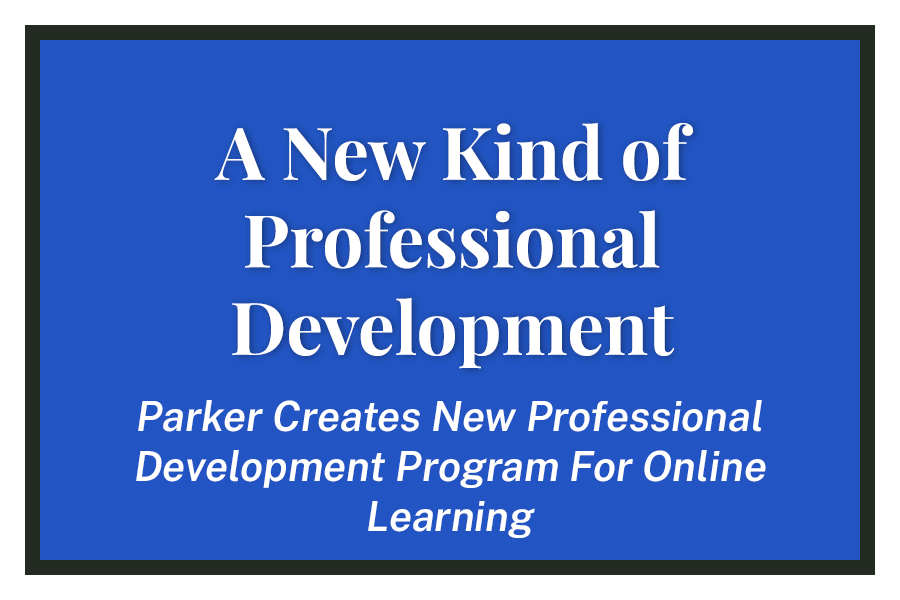A New Kind of Professional Development
Parker Creates New Professional Development Program For Online Learning
When teachers had to suddenly switch to online education in the spring, many began different styles of educating, each of which had certain upsides and downsides. During the summer, teachers had the opportunity to collaborate to teach each other what worked and what didn’t.
This approach to professional development is new to Parker and differs considerably from the norm. The approach was introduced to Parker by Matt Brown, a parent who works for Inquirium. Inquirium is an educational design company which, among other things, has been working on different methods of professional development.
“I am on the Education Council at Parker, and we were having a conversation about e-learning, and that combined with what I’ve seen with my own kids made me realize some of the challenges that teachers were facing in trying to create meaningful learning environments,” Brown said. “Given my background, I contacted Principal Dan Frank to see if I could help create a meaningful professional development program.”
Frank then passed the idea to Middle and Upper School Director of Studies Sven Carlsson and Lower and Intermediate School Director of Studies Barbara Hunt, who worked with Brown to create the “Teaching As Design” program. “We decided that the program would be most beneficial if teachers were not only learning from one another but also, using what they just learned, have time to work on how they could use this in their classes,” Carlsson said.
Another pitfall of professional development is that it so often deals in the theoretical, something Brown didn’t want. “Another thing we wanted to do,” Brown said, “is making sure what was being presented was rooted in actual case studies of what happened in the spring or experiences that teachers had in the spring.”
In years past a majority of professional development was taught by individuals outside the school. “It is just the progressive model that we teach in classrooms,” Carlsson said, “brought to professional development, something that was bound to happen eventually.”
Once the program details were finalized, an email was sent out to the faculty to see who would like to get involved. “When we sent out the invitation to join the program,” Brown said, “it started with just a few people trickling in, but then all of a sudden, a lot of people got involved.”
The program kicked off on July 27 and lasted three weeks, devoting the mornings to teaching strategies and the afternoons to teachers coming up with practical ways to incorporate the idea into their classes. “It was incredible seeing the faculty work together in this way,” said Carlsson, “and led to some amazing conversation.”
There were around 12 different workshops each led by different members of the faculty. “I led a workshop on teaching remotely in different ways,” Eighth Grade Math Teacher Timothy O’Connor said. “I basically described to my colleagues what things I had tried in the spring, what worked, what didn’t, and how I brainstormed new ideas.”
The effect of practicing the skill you just learned in professional development was very positive. “In a lot of professional development they give you a lot of information,” said Upper School Science Teacher Bridget Lesinski who attended multiple sessions. “But it can become overwhelming and because you haven’t applied any of the knowledge, so you’re less likely to actually incorporate it into your teaching,” said Lesinski.
Many teachers brought different perspectives on how to do remote learning. Because of the unique circumstances that the training took place during and the unique style of “Teaching As Design,” many conversations that ordinarily would not have come up did.
“One topic I wasn’t expecting to come up,” said Carlsson, “was the flipped method of teaching. This style of teaching, where students learn the material outside of class then in class you discuss the material, isn’t something I think would have ordinarily been discussed if it weren’t for online learning.”
Unlike a majority of professional development, this was cross-grade and cross-division. “The best part for me was actually seeing the teachers from the other divisions,” Lesinski said. “Many of them I knew, but some were kinda new to Parker. The fact that we were cross-divisional was great. I learned a lot from lower school and middle school teachers, and we realized that we had a lot to learn from each other.”







